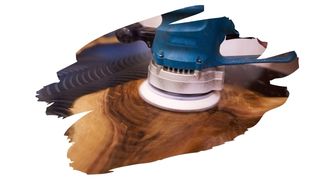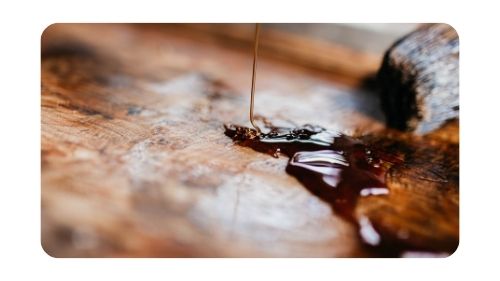Epoxy is one of the most beautiful sealants you can add to wood.
This clear resin product doesn’t change the color of lumber. However, once coated on, it can give wood grain an eye-popping glossy finish.
But, what if you’ve already added color to wood in the form of an oil finish?
It’s no secret that epoxy doesn’t adhere to greasy surfaces. But does that make applying epoxy over Danish oil a no-no?
Not quite.
You can apply epoxy over Danish oil, provided that the Danish oil finish has fully dried and cured.
The important detail here lies in the curing of Danish oil.
An oil finish that has dried is simply one that has turned from a liquid into a solid film. Which means it will be dry to the touch.
However, a cured oil finish is one that has turned from a solid film into a hard unyielding resin coat.
Epoxy won’t stay on a ‘dry’ oil finish. It will, on the other hand, happily stick to a ‘cured’ oil finish.
Now, Danish oil may only take a couple days or so to dry, but it can take weeks to cure.
And checking if Danish oil has cured isn’t as simple as checking if that oil finish is dry. A mere touch is all it takes to know if Danish oil has dried. But curing means that the oil has hardened both on the surface of that coat, and underneath the surface too.
Where people go wrong with epoxy top coats is with their timing. Basically, they apply epoxy before they are sure the Danish oil is wholly and completely cured through.
So, what do you need to know if you want to make sure that epoxy sticks to Danish oil? Well, let’s get into it…

This post may contain affiliate links to products that we receive a commission for (at no additional cost to you). Learn more here.
Can You (Or Even Should You) Epoxy Over Oiled Wood?
Well, provided the oil you are coating over is a cured drying oil, epoxy will adhere to it.
The only time you should avoid applying epoxy is if the oil finish is a ‘non-drying’ oil.
Non-drying finishing oils, like Mineral Oil or Lemon oil, don’t dry or cure. Instead, these food-safe oils stay permanently wet.
Which means that they cover wood in a greasy coat indefinitely. And that grease will have epoxy sliding off it, not sticking to it.
Drying oils, however, turn from greasy liquid, to greasy film, and then finally transform into a dry coat.
That dry coat will be free of grease, and so then it will be dry enough for epoxy to go over it.
Related Post: Can You Apply Epoxy Over A Tung Oil Finish?
What Is The Best Top Coat Finish Danish Oil?
After Danish oil cures, it leaves behind a nice satin finish. This finish leaves wood looking more rustically authentic than other types of finishes.
But while Danish oil offers good water resistance, (preventing decay and rot from springing up underneath the surface), it is not a waterproof sealant.
In other words, any top coat finish that seals wood up tight is the best finish for Danish oil. Two great choices for doing this are polyurethane and lacquer.
Polyurethane is tough, very scratch resistant, and it comes in high gloss, gloss, and satin. So if you want to keep Danish oils satin look, you don’t need to worry about polyurethane taking it away.
This type of finish is best for Danish oil coated woodwork that will undergo a lot of wear and tear, (like table tops).
Lacquer isn’t as durable as polyurethane. But what it lacks in comparative resilience, it more than makes up in ease of use. It is much easier to maintain and upkeep a lacquer finish. You can easily level out scratches and imperfections in lacquer.
This type of finish goes best on Danish oil coated decorative pieces that aren’t likely to be handled frequently.
Related Post: What Is The Difference Between Lacquer and Polyurethane?

Okay, So Then Why Use Epoxy Over Danish Oil At All?
Short answer? Because epoxy is very durable too. In fact, it is popularly used as floor coating material.
But, it isn’t anywhere near as scratch resistant as polyurethane. As while epoxy is harder and stronger, with that increased strength comes brittleness.
Epoxy simply doesn’t have the bit of elasticity that polyurethane otherwise has. And it is that elasticity that allows polyurethane to resist scratch-damage in a way that epoxy simply cannot.
It also gives off a nice – almost liquid looking – high glossy finish that seals all of that beautiful natural Danish oil color in.
Related Post: Can You Put Food Safe Epoxy Resin On Cutting Boards?
And How Long Does Danish Oil Take To Fully Cure?
It takes weeks for Danish oil to cure completely. Although factors such as humidity, room temperature, ventilation, and even the thickness of that film coat, all play a factor.
However, provided you’ve applied the oil correctly, (and you’ve also carefully wiped off all excess oil), it can take up to 30 days for Danish oil to cure throughout.
Related Post: Danish Oil Not Drying? What You Need To Know To Avoid Disaster!
So To Sum Up…
You can happily add epoxy over a Danish oil coat. But you need to play the waiting game first, making sure that oil finish has cured – both inside and out.
If you don’t, then any greasy areas still left uncured will shrug off that epoxy top coat.
References
Comparative study on the adhesive properties of different epoxy resins – ScienceDirect


